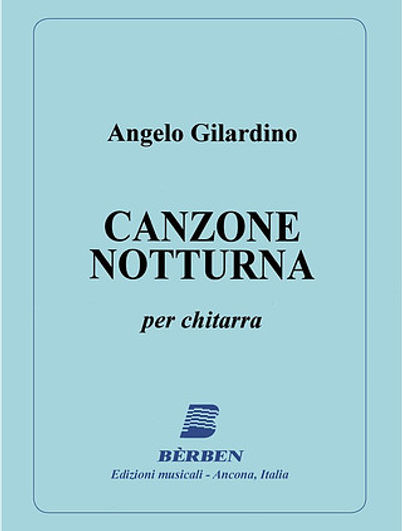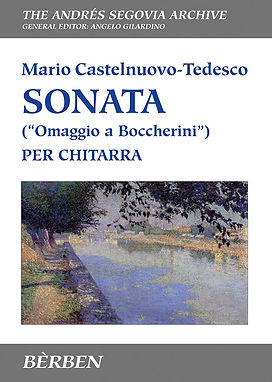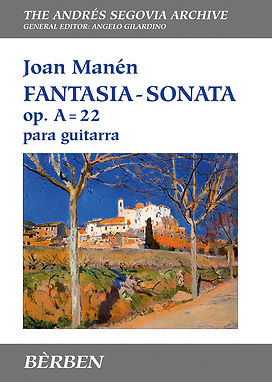

ANGELO GILARDINO
The editorial curator

ANGELO GILARDINO
and FABIO BOCCOSI
Fabio Boccosi, the son of Maestro Bio Boccosi (a musician with a great passion for the accordion, an instrument for which he composed numerous pieces, and owner of Bèrben purchased in the early 1960s by guitarist Benedetto Berlini from Modena) in the late 1960s worked in the family's publishing house dealing in particular with the world of Classical Guitar, maintaining relations with many guitarists for whom Bèrben has always represented an important point of reference. From the very first meetings, Fabio Boccosi had forged a particularly intense relationship with ANGELO GILARDINO, whom he had met thanks to M.° Mario Castelnuovo-Tedesco, both for the musical and professional exchange and for the personal understanding that quickly turned into a great friendship destined to last a lifetime.
The first contract that Fabio Boccosi stipulated between Angelo and Bèrben envisaged the publication of 'Canzone Notturna'; in the contract the handwritten notes by Angelo Gilardino demonstrate the cordial, ironic and brilliant tone that would long characterise their relationship. It was 1969, and it was at that time that Angelo was appointed Editorial Director of the collection that would be Bèrben's 'flagship' for decades: 'La collezione di musiche per chitarra', dedicated to the original repertoire that Gilardino himself brought forth from the 'pen' of many of the most important composers of the 20th century.
The group of musicians whose pieces are included in the collection is very rich and significant: from Mario Castelnuovo-Tedesco to John Duarte and Leo Brouwer, from Stephen Dodgson, Hans Haug and Bruno Bettinelli to Astor Piazzolla. The collection with its unmistakable 'carmine-red' cover has earned itself a leading role in the guitar repertoire of the 20th century, due to the high musical level and compositional quality of the pieces that, thanks to Angelo Gilardino and Fabio Boccosi, have entered its prestigious list.





His historical publisher (Schott), in fact, was unable to publish the collection since the Spanish concert guitarist had no time to edit it: in the end, at Clara Castelnuovo-Tedesco's insistence, Schott resigned and left us free. It was a publishing coup of great resonance, and I immediately set to work to quickly publish all four notebooks complete with text and music, despite complicated contractual negotiations with the heirs of the Spanish author of the poems and the American publisher of the English version. But in those days, I did not even care about the prestige and future economic benefits of these 'publishing scoops': the thrill of putting great composers under contract, receiving their manuscripts, reading them at the piano, checking the proofs with Angelo, and finally receiving the copies with their freshly printed scent of paper, were all priceless sensations that were enough to gratify our youthful enthusiasm...
Then I remember all the summer trips to Roasio and Trivero (in the magical atmosphere of the 'guitar holidays' organised by Angelo), the trip to Venice for the jury meeting of the guitar composition prize named in memory of Castelnuovo-Tedesco (where we brought together great musicians such as Ruggero Chiesa, Alvaro Company, John Duarte and Alexandre Tansman), and then the trip that took us to Zagreb, where the Italian Institute of Culture organised conferences and meetings with enthusiastic local guitarists (in the early 1980s, the then Yugoslavia was still somewhat isolated from the international guitar world): at the end we left them full of joy and gratitude, giving them the whole mountain of music I had loaded into my car!
“MORE THAN SIXTY YEARS
WITH ANGELO GILARDINO"
(a memory by Fabio Boccosi)
It all began in... fateful year 1946: I was born in Ancona in 1946, while in the same year Benedetto Berlini set up the Berben publishing house in Modena, also in 1946 my father started the Farfisa music publishing business in Ancona (within the musical instrument factory of the same name). Then, in the early 1960s, my father bought the Berben publishing house from Berlini, brought everything to Ancona, and asked me to help him reorganise it (indeed, he imposed it on me, given my poor results in high school studies!). So it was that, right in the period of the 'economic boom' (which had also exploded in the field of musical instruments and publishing), I began to frequent all the guitarists (thanks to the efficient service I provided them, importing methods and music for guitar from all over the world), including the young Angelo Giardino, with whom I immediately got on well: we thus became fraternal friends forever. I still remember the first editorial contract I sent him in 1969 for his 'Canzone notturna', a document on which Angelo added hilarious self-deprecating notes in pencil ('Then I can't do anything nocturnal any more?' and 'I recommend combining it with films about difficult childbirths!').
Thus began an extraordinary editorial adventure, which led us to call upon the best-known composers from all over the world to convince them to write new music for the newly-born 'Collection of guitar music directed by Angelo Giardino'. Naturally, the jewels in the crown were immediately the works of Mario Castelnuovo-Tedesco: I still remember the trip we made to Florence to meet the composer's widow (who was visiting Italy), to convince her to give us the beautiful series of "Platero y yo" for narrator and guitar, already well known for some pieces performed and recorded by Segovia.





But at some point, by mutual agreement, we decided to simply destroy them all! Who knows, perhaps it was the modesty of our judgements (sometimes a bit impulsive) and the fear of provoking unpleasant misunderstandings, with the risk of fuelling the usual gossip and stirring up the inevitable envy present in the guitar world (but, more or less, everywhere!), and unfortunately not least the mutual involvement in some dramatic events of our youth...
The fact is that, of all the fantastic stories and evocative events Angelo wrote to me over all these years, what remains only in my most precious memories...
Lately, we had almost regretted it: when Angelo was writing his autobiography (later published in the beautiful and at times poignant book "Io, la chitarra e altri incontri" in 2016), he asked me if I had kept anything of our correspondence in the archives, perhaps because it could be useful to him to enrich his 'memoirs of an artist'.
I searched frantically for a long time in all my archives, but could not find any more letters from him: I had kept faith with our strange pact, and so our 'cupio dissolvi' had not been waived! But in the end, the spirit instilled in me by Angelo over more than 60 years is still alive in me and in all those who had the privilege of knowing him, and will be forever!
Fabio Boccosi April 2023.
And what can we say about the thrill we felt, at the beginning of the new century, when Segovia's widow, thanks to her confidence in Angelo's supervision, finally had the great guitarist personal coffers opened, thus giving light to the many music manuscripts of great 20th century composers that we thought had been lost forever? Publishing almost all of them, then, was the most rewarding occupation of my last years with Angelo: the choice of the magnificent cover paintings and the painstaking complete editions of the original manuscripts were such exciting jobs that the related financial commitment remained for both of us (as always) in the background!
Obviously, in all these years, we exchanged thousands of letters: on work-related topics, of course, but also on various aspects of everyday life. Our extravagant youthful exuberance, however, was overshadowed by our unresolved existential problems, which we began to dig into, 'psychoanalysing' each other: at a certain point, more or less naively, we began to engage in subtle provocations and daring banter, as if to test our reactions, which were not long in coming (we were waiting for nothing else!), in what became a continuous epistolary challenge....... The publication of this correspondence today would be enlightening and of a certain historical interest (although perhaps not up to the level of the fascinating correspondence between Segovia and Castelnuovo-Tedesco, published by Angelo in 2018!), especially for Angelo's priceless ability to evoke stories, advice and considerations: each of his letters was as gripping as a novel and always written with a brilliant eloquence, on a par with the greatest writers (so much so that I reread them, admiringly, several times a day!).



Photo: ANDREA CHERCHI


